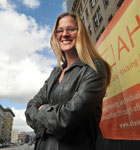Susan Friedland cares about beauty. She also cares about Berkeley, California’s low-income population, which includes many families, seniors, and individuals with special needs. As the executive director of Affordable Housing Associates (AHA), Friedland combines her passions by developing sustainable, affordable housing. Since its inception in 1993, AHA has developed and preserved more than 900 high-quality, cost-friendly apartments, and this year alone it has added four new projects and will start three more before the end of the year. By mid-2012, AHA will have built more than 1,100 homes housing more than 2,500 people. Here, Friedland explains her sustainability strategies in her own words.
Commit to the community. At AHA we look everywhere for new site opportunities—foreclosed buildings, vacant hotels, old parking lots, city-owned sites. Then we work with our neighbors, local community stakeholders, and elected officials to create a building design that meets local housing standards and helps to improve the neighborhood. We carefully oversee the design and construction to ensure that green-building techniques and technology are fully incorporated at all phases. Finally, we transition the building from a construction project to an operational apartment building, and we provide our new residents the supportive services they need to thrive in their new homes.
Invest in the process. We care a lot about investing up front in the highest-quality materials that will prove to be durable, attractive, and easy to use and repair. We focus on green building both because it is synergistic with our mission [and] because it enables us to save on our monthly operating costs. We are then able to pass this savings along to our low-income residents in the form of lower rents. Ultimately, it’s an investment that gives back.
Strive for beauty. In our buildings, there is a feeling of safety, of peacefulness, of beauty. I think great buildings make use of natural light, colors, and volumes of space to enhance these senses. It sounds a little odd, but I really care about indoor air quality; we make sure [that] we have the best ventilation and use nontoxic paints, glues, and carpet. And I care a lot about landscaping around the buildings and in the outdoor spaces. Fortunately, in California, we can make great use of native vegetation, drought-tolerant plants, and also create productive community-gardening opportunities at our buildings.

Harmon Gardens, which provides 15 new apartments for youths coming in off the streets, was 10 years in the making. The LEED Platinum building features a native landscape, solar panels, and covered bike parking.
Participate in local programs. AHA has, since [its] inception, participated in pilot programs in furtherance of various green initiatives. In addition to LEED, AHA participates in environmentally conscious building programs like GreenPoint Rated Multifamily, Bay-Friendly Landscaping [& Gardening Coalition], EPA Indoor airPLUS, and [California] Multifamily New Homes. We consider these programs to be essential green-building guides for the continually expanding knowledge base of architects, contractors, and developers. Using these programs, we’ve strived to develop a holistic approach to green building that balances the needs of our resident communities and buildings while maintaining the economic and health benefits that green building can bring to both.
Never abandon your dreams. The Harmon Gardens project is the culmination of a 10-year dream. A decade ago, AHA purchased a small seven-unit building from a negligent landlord. The space was in bad shape, but one of AHA’s founding board members had a vision that someday we could transform the building into housing for one of the Bay Area’s most underserved populations—homeless youth. After very careful planning and work with [HKIT Architects], the Bay-Friendly Landscape & Gardening Coalition, StopWaste.org, Build It Green, Heschong Mahone Group, and AHA’s own in-house design and construction team, we designed and built 15 new apartments that make up a beautiful and safe home to youth who had been living on the streets. The Harmon Gardens project will feature covered bike parking [and] solar panels for electric and domestic heating and hot water, and [it] will achieve a LEED Platinum rating in the LEED for Homes mid-rise pilot program.

